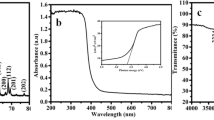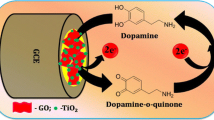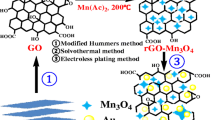Abstract
A non-enzymatic dopamine electrochemical sensing probe was developed. A hexagonal shape zinc-doped cobalt oxide (Zn-Co2O4) nanostructure was prepared by a facile hydrothermal approach. The combination of Zn, which has an abundance of electrons, and Co3O4 exhibited a synergistically electron-rich nanocomposite. The crystallinity of the nanostructure was investigated using X-ray diffraction. A scanning electron microscope (SEM) was used to examine the surface morphology, revealing hexagonal nanoparticles with an average particle size of 400 nm. High-resolution transmission electron microscopy (HR-TEM) was used to confirm the nanostructure of the doped material. The nanostructure’s bonding and functional groups were verified using Fourier transform infrared spectroscopy (FTIR). The electrochemical characterization was conducted by using electrochemical impedance spectroscopy (EIS), cyclic voltammetry (CV), and amperometry. The resistivity of the electrode was confirmed through EIS and showed that the bare glassy carbon electrode (GCE) exhibited higher charge transfer resistance as compared to modified Zn-Co2O4/GCE. The sensing probe was developed by modifying the surface of GCE with Zn-Co2O4 nanostructure and tested as an electrochemical sensor for dopamine oxidation; it operated best at a working potential of 0.17 V (vs Ag/AgCl). The developed sensor exhibited a low limit of detection (0.002 µM), a high sensitivity (126 µA. µM−1 cm−2), and a wide linear range (0.2 to 185 µM). The sensor showed a short response time of < 1 s. The sensor’s selectivity was investigated in the presence of coexisting species (uric acid, ascorbic acid, adrenaline, epinephrine, norepinephrine, histamine, serotonin, tyramine, phenethylamine, and glucose) with no effects on dopamine determination results. The developed sensor was also successfully used for determining dopamine concentrations in a real sample.
Graphical abstract










Similar content being viewed by others
References
Chauhan N et al (2020) Recent advancement in nanosensors for neurotransmitters detection: present and future perspective. Process Biochem 91:241–259
Mani V et al (2016) Determination of dopamine using a glassy carbon electrode modified with a graphene and carbon nanotube hybrid decorated with molybdenum disulfide flowers. Microchim Acta 183(7):2267–2275
Govindasamy M et al (2018) Determination of neurotransmitter in biological and drug samples using gold nanorods decorated f-MWCNTs modified electrode. J Electrochem Soc 165(9):B370
Devasenathipathy R et al (2014) Electrodeposition of gold nanoparticles on a pectin scaffold and its electrocatalytic application in the selective determination of dopamine. RSC Adv 4(99):55900–55907
Carrera V et al (2007) A simple and rapid HPLC–MS method for the simultaneous determination of epinephrine, norepinephrine, dopamine and 5-hydroxytryptamine: application to the secretion of bovine chromaffin cell cultures. J Chromatogr B 847(2):88–94
Wu H-P, Cheng T-L, Tseng W-L (2007) Phosphate-modified TiO2 nanoparticles for selective detection of dopamine, levodopa, adrenaline, and catechol based on fluorescence quenching. Langmuir 23(14):7880–7885
Mamiński M et al (2005) Spectrophotometric determination of dopamine in microliter scale using microfluidic system based on polymeric technology. Anal Chim Acta 540(1):153–157
Lapainis T et al (2007) A multichannel native fluorescence detection system for capillary electrophoretic analysis of neurotransmitters in single neurons. Anal Bioanal Chem 387(1):97–105
Abdolmohammad-Zadeh H, Zamani-Kalajahi M (2020) A novel chemiluminescent-based nano-probe for ultra-trace quantification of dopamine in human plasma samples. Microchem J 155:104704
Govindasamy M et al (2016) Simultaneous determination of dopamine and uric acid in the presence of high ascorbic acid concentration using cetyltrimethylammonium bromide–polyaniline/activated charcoal composite. RSC Adv 6(102):100605–100613
Kim Y-R et al (2010) Electrochemical detection of dopamine in the presence of ascorbic acid using graphene modified electrodes. Biosens Bioelectron 25(10):2366–2369
Keerthi M et al (2019) A core-shell molybdenum nanoparticles entrapped f-MWCNT s hybrid nanostructured material based non-enzymatic biosensor for electrochemical detection of dopamine neurotransmitter in biological samples. Sci Rep 9(1):1–12
Kogularasu S et al (2017) 3D graphene oxide-cobalt oxide polyhedrons for highly sensitive non-enzymatic electrochemical determination of hydrogen peroxide. Sens Actuators, B Chem 253:773–783
Kim D-S et al (2018) Electrochemical detection of dopamine using periodic cylindrical gold nanoelectrode arrays. Sci Rep 8(1):1–10
Abdelwahab AA, Shim Y-B (2015) Simultaneous determination of ascorbic acid, dopamine, uric acid and folic acid based on activated graphene/MWCNT nanocomposite loaded Au nanoclusters. Sens Actuators, B Chem 221:659–665
Xie Y-L et al (2015) Facile ultrasonic synthesis of graphene/SnO2 nanocomposite and its application to the simultaneous electrochemical determination of dopamine, ascorbic acid, and uric acid. J Electroanal Chem 749:26–30
Aparna T, Sivasubramanian R, Dar MA (2018) One-pot synthesis of Au-Cu2O/rGO nanocomposite based electrochemical sensor for selective and simultaneous detection of dopamine and uric acid. J Alloy Compd 741:1130–1141
Chen D et al (2018) Electrochemical determination of dopamine using a glassy carbon electrode modified with a nanocomposite consisting of nanoporous platinum-yttrium and graphene. Microchim Acta 185(2):1–7
Oztekin Y et al (2012) Copper nanoparticle modified carbon electrode for determination of dopamine. Electrochim Acta 76:201–207
Hsieh Y-S, Hong B-D, Lee C-L (2016) Non-enzymatic sensing of dopamine using a glassy carbon electrode modified with a nanocomposite consisting of palladium nanocubes supported on reduced graphene oxide in a nafion matrix. Microchim Acta 183(2):905–910
He Q et al (2019) A promising sensing platform toward dopamine using MnO2 nanowires/electro-reduced graphene oxide composites. Electrochim Acta 296:683–692
Rajaji U et al (2020) A nanocomposite consisting of cuprous oxide supported on graphitic carbon nitride nanosheets for non-enzymatic electrochemical sensing of 8-hydroxy-2′-deoxyguanosine. Microchim Acta 187(8):1–10
Numan A et al (2017) Binary nanocomposite based on Co 3 O 4 nanocubes and multiwalled carbon nanotubes as an ultrasensitive platform for amperometric determination of dopamine. Microchim Acta 184(8):2739–2748
Chen J, Wu X, Selloni A (2011) Electronic structure and bonding properties of cobalt oxide in the spinel structure. Phys Rev B 83(24):245204
Mani V et al (2020) Growth of large-scale MoS 2 nanosheets on double layered ZnCo 2 O 4 for real-time in situ H 2 S monitoring in live cells. J Mater Chem B 8(33):7453–7465
An C et al (2019) Metal oxide-based supercapacitors: progress and prospectives. Nanoscale Adv 1(12):4644–4658
Nguyen T, Montemor MdF (2019) Metal oxide and hydroxide–based aqueous supercapacitors: from charge storage mechanisms and functional electrode engineering to need-tailored devices. Adv Sci 6(9):1801797
Suneetha RB, Selvi P, Vedhi C (2019) Synthesis, structural and electrochemical characterization of Zn doped iron oxide/grapheneoxide/chitosan nanocomposite for supercapacitor application. Vacuum 164:396–404
Wang B et al (2017) Semiconductor-ionic membrane of LaSrCoFe-oxide-doped ceria solid oxide fuel cells. Electrochim Acta 248:496–504
George JM, Antony A, Mathew B (2018) Metal oxide nanoparticles in electrochemical sensing and biosensing: a review. Microchim Acta 185(7):1–26
Baye AF et al (2020) Graphene oxide interlayered Ga-doped FeSe2 nanorod: a robust nanocomposite with ideal electronic structure for electrochemical dopamine detection. Electrochim Acta 363:137245
Manjula N et al (2021) Facile synthesis of hexagonal-shaped zinc doped cobalt oxide: application for electroanalytical determination of antibacterial drug ofloxacin in urine samples. J Electroanalyt Chem 885:115101
Sakthinathan S et al (2016) Reduced graphene oxide non-covalent functionalized with zinc tetra phenyl porphyrin nanocomposite for electrochemical detection of dopamine in human serum and rat brain samples. Electroanalysis 28(9):2126–2135
Mani V et al (2019) ZnCo2O4 nanoflowers grown on Co3O4 nanowire-decorated Cu foams for in situ profiling of H2O2 in live cells and biological media. ACS Appl Nano Mater 2(8):5049–5060
Long H et al (2016) Nanowire-assembled hierarchical ZnCo2O4 microstructure integrated with a low-power microheater for highly sensitive formaldehyde detection. ACS Appl Mater Interfaces 8(46):31764–31771
Liu X et al (2018) Nanoporous Zn-doped Co3O4 sheets with single-unit-cell-wide lateral surfaces for efficient oxygen evolution and water splitting. Nano Energy 44:371–377
Jincy C, Meena P (2020) Synthesis, characterization, and NH3 gas sensing application of Zn doped cobalt oxide nanoparticles. Inorg Chem Commun 120:108145
Jayabal S, Ramaraj R (2013) Synthesis of core/shell Au/Ag nanorods embedded in functionalized silicate sol–gel matrix and their applications in electrochemical sensors. Electrochim Acta 88:51–58
Younus AR et al (2019) Nonenzymatic amperometric dopamine sensor based on a carbon ceramic electrode of type SiO 2/C modified with Co 3 O 4 nanoparticles. Microchim Acta 186(7):1–10
Zhuang X et al (2018) Reduced graphene oxide functionalized with a CoS 2/ionic liquid composite and decorated with gold nanoparticles for voltammetric sensing of dopamine. Microchim Acta 185(3):1–9
Xing L, Ma Z (2016) A glassy carbon electrode modified with a nanocomposite consisting of MoS 2 and reduced graphene oxide for electrochemical simultaneous determination of ascorbic acid, dopamine, and uric acid. Microchim Acta 183(1):257–263
Mei L-P et al (2016) A glassy carbon electrode modified with porous Cu 2 O nanospheres on reduced graphene oxide support for simultaneous sensing of uric acid and dopamine with high selectivity over ascorbic acid. Microchim Acta 183(6):2039–2046
Numan A et al (2017) Facile fabrication of cobalt oxide nanograin-decorated reduced graphene oxide composite as ultrasensitive platform for dopamine detection. Sens Actuators, B Chem 238:1043–1051
Ejaz A, Joo Y, Jeon S (2017) Fabrication of 1, 4-bis (aminomethyl) benzene and cobalt hydroxide@ graphene oxide for selective detection of dopamine in the presence of ascorbic acid and serotonin. Sens Actuators, B Chem 240:297–307
Umapathi S et al (2020) Electrochemical sensor based on CuSe for determination of dopamine. Microchim Acta 187(8):1–13
Firooz AA et al (2021) High electrochemical detection of dopamine based on Cu doped single phase hexagonally ZnO plates. Mater Today Commun 26:101716
Durai L, Gopalakrishnan A, Badhulika S (2021) One-pot hydrothermal synthesis of NiCoZn a ternary mixed metal oxide nanorod based electrochemical sensor for trace level recognition of dopamine in biofluids. Mater Lett 298:130044
Acknowledgements
The authors are thankful to the Higher Education Commission (HEC), Pakistan, for the NRPU Project No. 5358 as financial assistance and King Fahd University of Petroleum and Minerals, Kingdom of Saudi Arabia, under Project No. DF191016.
Author information
Authors and Affiliations
Corresponding authors
Ethics declarations
Conflict of interest
The authors declare no competing interests.
Additional information
Publisher's note
Springer Nature remains neutral with regard to jurisdictional claims in published maps and institutional affiliations.
Supplementary Information
Below is the link to the electronic supplementary material.
Rights and permissions
About this article
Cite this article
Khan, M.I., Muhammad, N., Tariq, M. et al. Non-enzymatic electrochemical dopamine sensing probe based on hexagonal shape zinc-doped cobalt oxide (Zn-Co2O4) nanostructure. Microchim Acta 189, 37 (2022). https://doi.org/10.1007/s00604-021-05142-z
Received:
Accepted:
Published:
DOI: https://doi.org/10.1007/s00604-021-05142-z




